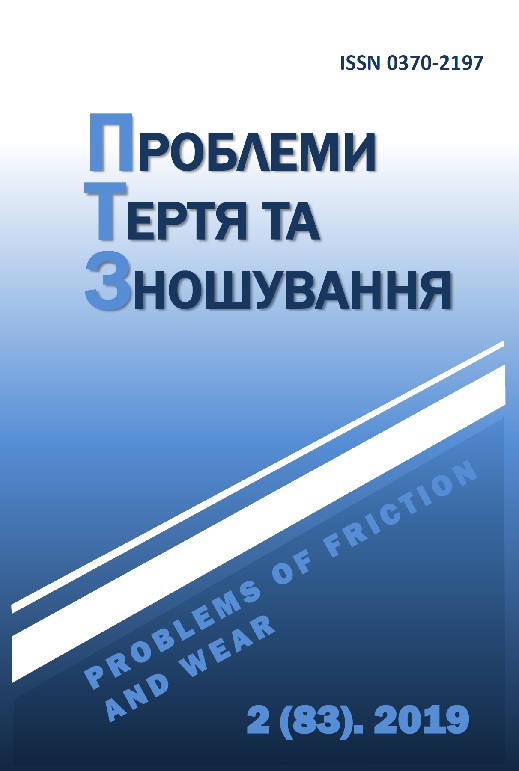TO THE QUESTION OF THE ESTIMATION OF HEAT BALANCE OF THE SYSTEM OF ADVANCED COOLING WITH NANOTHELD CARRIERS OF THE FRIENDS OF DISC-SHOE BRAKE OF DIFFERENT CATEGORIES OF VEHICLE
DOI:
https://doi.org/10.18372/0370-2197.2(83).13686Keywords:
vehicle, self-ventilated disc-shoe brake, half-disks with chambers, hollow spikes, nanofiberAbstract
Improving the safety of vehicles in steadily increasing their flows on the roads of the country is closely linked to the effectiveness of the disc-shoe brakes. The performance of their friction pairs depends on the energy loading of the brake assembly. The use of self-ventilated discs in the brakes does not satisfy the condition for reducing their energy load. This is explained by the fact that the brake mechanisms have a limited construction volume; therefore, it is not possible to increase the area of heat exchange surfaces in self-ventilated brake discs. In addition, the heat transfer coefficient of forced air convection is tens of times less than with other types of forced cooling (for example, with indirect forced water cooling of friction pairs of a vehicle disk-brake brake).
The dynamic viscosity of a fluid is primarily due to the molecular interaction that limits the mobility of molecules. In a liquid, a molecule can penetrate into the neighboring layer only when a crack appears in it, which is sufficient to introduce the molecule into it. The formation of cracks (to “loosening” the liquid) consumes the so-called activation energy of viscous friction. This energy decreases with increasing temperature and decreasing pressure. This is one of the reasons for the sharp decrease in the viscosity of a liquid with increasing temperature and its growth at high pressures.
The appearance of spatial structures formed by macromolecules in dispersed systems causes a sharp increase in viscosity.
With the flow of a structured fluid, the work of an external force is expended not only to overcome the true (Newtonian) viscosity, but also to destroy the structure.
The viscosity of a liquid depends on the chemical structure of the molecules and increases with increasing molecular weight.
The thermal conductivity coefficient of nanofluid is a function of time. The following components influence the thermal conductivity coefficient of nanofluids: kinetic, potential, collisional, potential-kinetic, collisional-kinetic, potential-collisional. In this case, the interaction of the carrier medium with the nanoparticle is determined by the potential-kinetic potential.
According to the molecular-dynamic theory of the phase trajectories of nanoparticles in a liquid and in saturated wet steam that are in the cooling system of a disk-brake brake, their local instability and mixing take place. It should be borne in mind that the nanoparticles in the water are covered with a film, which contributes to an increase in the heat transfer coefficient.
The method of estimating the heat balance of an indirect cooling system with nano-fluid friction pairs of a disk-brake brake of various categories of vehicles moving in the brake mode and freely implemented in four stages.
The method for estimating the heat balance of an indirect cooling system with nano-carriers of friction pairs of a disk-brake brake of various categories of vehicles in motion and braking mode is implemented in two stages.
Thus, the prediction of the thermal balance of the indirect cooling system with nano-heat carriers of friction units of the disk-brake brake of various vehicles allows evaluating each of the two-phase coolant states of the effectiveness of reducing the energy load of friction pairs of the brake.
References
Особенности оценки интенсивности теплообмена самовентилируемых дисково-колодочных тормозов транспортных средств // Н. А. Вольченко, Д. А. Вольченко, А. И. Вольченко [и др.] // Восточно-Европейский журнал передовых технологий. – Харьков, №1/5(97), 2019 – С. 47-53.
К вопросу оценки теплового баланса сплошных дисков тормозов в подкатего-риях транспортных средств / Н. А. Вольченко, Д. А. Вольченко, В. С. Скрыпник [и др.] // Проблеми тертя та зношування. – Киев. – 2018. – №3 (80). – С. 16-23.
Рудяк В Я., Краснолуцкий С. Л. Моделирование коэффициентов теплопровод-ности наножидкости с малыми частицами методом молекулярной динамики / В. Я. Ру-дяк, С. Л. Краснолуцкий // Журнал технической физики. 2017. Т. 87. Вып. 10 – С. 1450-1458.
Измерение коэффициента теплоотдачи наножидкости на основе воды и частиц окиси меди / А. В. Минаков, В. Я. Рудяк, Д. В. Гузей, А. С. Лобасов // ТВТ, том 53, вып 2, 2015. – С. 258-263.
Терехов В. И., Калинина С. В., Леманов В. В. Механизмы теплопереноса в наножидкостях: современное состояние проблемы. Ч. 2. Конвективный теплообмен // Теплофизика и аэромеханика, 2010. №2. – С. 173.
Рудяк В. Я., Белкин А. А., Томлина Е. А. О коэффициенте теплопроводности наножидкостей // Письма в ЖТФ. 2010. Т. 36. Вып. 14. – С. 49.
Рудяк В. Я., Белкин А. А. Моделирование коэффициентов переноса наножидко-стей // Наносистемы: физика, химия, математика. 2010. Т. 1. №1. – С. 156.
Цветков Ф. Ф., Григорьев Б. А. Тепломассообмен. М.: Изд-во МЭИ, 2005. – 215с.

